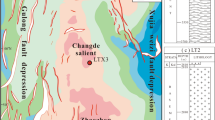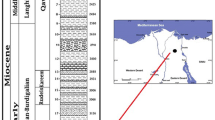Abstract
Different pore types and variable pore structures can determine reservoir potentials of volcanic rocks. Therefore, it is of great importance to understand the pore structures of volcanic reservoirs. With the Lower Cretaceous Yingcheng volcanic rocks, this study attempts to investigate and evaluate the micro pore structures of a volcanic reservoir through: (1) measuring porosity and permeability of core samples; (2) identifying pore types within thin sections; (3) characterizing pore structures with pressure-controlled mercury injection. The Lower Cretaceous Yingcheng volcanic rocks exhibits low porosities (on average 7.39%) and very low permeability (on average 0.283 × 10−6 m2). Three major pore types were identified from the Lower Cretaceous Yingcheng volcanic reservoir, including primary pores, secondary pores and fractures. Additionally, the pore structures of the Lower Cretaceous Yingcheng volcanic reservoir can be classified into three types. Type I pore structure primarily occurs in the volcanic breccia, crystal tuff and tuffites. The corresponding pore system is dominated by primary intergranular pores, intragranular dissolved pores and devitrified micropores with porosity and permeability higher than 5.4% and 0.05 × 10−6 µm2, respectively. Corresponding mercury intrusion curves are characterized by low displacement pressure, high maximum mercury saturation and mercury withdrawal efficiency. Type II pore structure is commonly observed in the tuff and tuffites, while primary intergranular pores and secondary micropores dominate pore system with porosity of 2.5–5.4% and permeability of 0.012–0.05 × 10−6 m2. The mercury intrusion curves are similar to the type I. Type III pore structure is also pervasively developed in the crystal tuff and tuffites. Intragranular dissolved micropores are most important ones with porosity and permeability less than 2.5% and 0.01 × 10−6 m2, respectively. Different from type I and II pore structure, the mercury intrusion curves of the type III have high-displacement pressure, low maximum mercury saturation and mercury withdrawal efficiency, indicating poor reservoir quality.











Similar content being viewed by others
References
Cass RAF, Wright JV (1987) Volcanic successions: modern and ancient. J Volcanol Geotherm Res 39:355–356
Chen JT, Qiu ZY, Zhang WP (2011) Relationship between volcanic rocks and hydrocarbon accumulation during dominant period of basin formation in Liaohe depression. Acta Sedimentol Sin 4:023
De’Genaro M. Capelletti P, Langella A, Perrotta A, Scarpati C (2000) Genesis of zeolites in the Neapolitan Yellow Tuff: geological, volcanological and mineralogical evidence. Contrib Mineral Petrol 139:17–35
Dobson PF, Kneafsey TJ, Hulen J, Simmons A (2003) Porosity, permeability and fluid flow in the Yellowstone geothermal system, Wyoming. J Volcanol Geotherm Res 123:313–324
Feng ZQ (2008) Volcanic rocks as prolific gas reservoir: a case study from the Qingshen gas field in the Songliao Basin, NE China. Mar Pet Geol 25:416–432
Feng ZH, Yin CH, Liu JJ, Zhu YK, Lu JM, Li JH (2014) Formation mechanism of in-situ, volcanic reservoirs in eastern China: a case study from Xushen gasfield in Songliao basin. Sci China Earth Sci 57:2998–3014
Gao R, Cai X (1997) Formation and occurrence of giant oilfields in the Songliao Basin. Pet Explor Dev 24:30–46
Gong L, Gao S, Fu X, Chen S, Lyu B, Yao J (2017) Fracture characteristics and their effects on hydrocarbon migration and accumulation in tight volcanic reservoirs: a case study of the Xujiaweizi fault-depression, Songliao basin, China. Interpretation 5(4):57–70
Huang WB, Hersi OS, Lu SF, Deng SW 2017 Quantitative modelling of hydrocarbon expulsion and quality grading of tight oil lacustrine source rocks: case study of Qingshankou 1 member, central depression, Southern Songliao Basin, China. Mar Pet Geol 84: 34–48
Jia J, Liu Z, Bechtel A, Strobl SAI, Sun P (2013) Tectonic and climate control of oil shale deposition in the Upper Cretaceous Qingshankou Formation (Songliao Basin, NE China). Int J Earth Sci 102:1717–1734
Knutson J (1994) Volcanic textures: a guide to the interpretation of textures in volcanic rocks. Bull Volcanol 56:412–413
Lenhardt N, Götz AE (2011) Volcanic settings and their reservoir potential: an outcrop analog study on the Miocene Tepoztlán Formation, central Mexico. J Volcanol Geotherm Res 204:66–75
Lenhardt N, Götz AE (2015) Geothermal energy from deep sedimentary basins: the Valley of Mexico (Central Mexico). In: EGU General Assembly Conference (vol 17). EGU General Assembly Conference Abstracts
Levin LE (1995) Volcanogenic and volcaniclastic reservoir rocks in Mesozoic–Cenozoic island arcs: examples from the Caucasus and the NW Pacific. J Pet Geol 18:267–288
Luo J, Morad S, Liang Z, Zhu Y (2005) Controls on the quality of Archean metamorphic and Jurassic volcanic reservoir rocks from the Xinglongtai buried hill, western depression of Liaohe Basin, China. AAPG Bull 89:1319–1346
Mccreech CA, Ehrlich R, Crabtree SJ (1991) Petrography and reservoir physics II: relating thin section porosity to capillary pressure, the association between pore types and throat size. AAPG Bull 75:1563–1578
Mitsuhata Y, Matsuo K, Minegishi M (1999) Magnetotelluric survey for exploration of a volcanic-rock reservoir in the Yurihara oil and gas field, Japan. Geophys Prospect 47:195–218
Mozley PS, Heath JE, Dewers TA, Bauer SJ (2016) Origin and heterogeneity of pore sizes in the Mount Simon sandstone and Eau Claire formation: implications for multiphase fluid flow. Geosphere 12:1341–1361
Nakata JK (1980) Distribution and petrology of the Anderson-Coyote Reservoir volcanic rocks, California. Open-file report—US geological survey, p 130
Patricia S, Nora R (2007) Processes controlling porosity and permeability in volcanic reservoirs from the Austral and Neuquén Basins, Argentina. AAPG Bull 91:115–129
Phillips WJ (1972) Hydraulic fracturing and mineralization. J Geol Soc 128: 337–359
Sakata S, Takahashi M, Igari SI, Noriyuki S (1989) Origin of light hydrocarbons from volcanic rocks in the ‘‘Green Tuff’’ region of northeast Japan: biogenic versus magmatic. Chem Geol 74:241–248
Schowalter TT (1979) Mechanics of secondary hydrocarbon migration and entrapment. AAPG Bull 63:723–760
Sembodo I (1973) Notes on formation evaluation in the Jatibarang volcanic reservoir. In: Proceedings of the annual convention—Indonesian Petroleum Association: ges pp 131–147
Shan HZ, Xuan l, Guo L (2017) The identification and modeling of the volcanic weathering crust in the Yingcheng Formation of the Xujiaweizi fault depression, Songliao Basin. Acta Geol Sin (English Edition) 91:1339–1351
Smith RL 1960 Ash flows. Geol Soc Am Bull 71: 795–842
Sruoga P, Rubinstein N, Hinterwimmer G (2004) Porosity and permeability in volcanic rocks, a case study on the Serie Tobifera, South Patagonia, Argentina. J Volcanol Geotherm Res 132:31–43
Tang H, Ji H (2006) Incorporation of spatial characteristics into volcanic facies and favorable reservoir prediction. Spe Reserv Eval Eng 9:565–573
Wang C, Hou G, Jianghai LI, Liu W, Dian HE (2008) Analysis on the control factors of the reservoir capabilities of the volcanic rocks in Xujiaweizi, Daqing. Acta Scientiarum Naturalium Universitatis Pekinensis 44(6):909–914
Wang W, Wang M, Lu S, Chen S, Zheng M, Wu X (2016) Basin modelling of gas migration and accumulation in volcanic reservoirs in the Xujiaweizi fault depression, Songliao Basin. Arab J Geosci 9:166
Wang M, Lu S, Wang W, Chen S, Zhang X, Guan Y (2017) Gas migration and accumulation modelling in volcanic reservoirs, Xujiaweizi fault depression, Songliao Basin. Earth Sci 9(166):21–45
Wu J (2015) Identification of volcanic lithology and reservoir with petrophysical elastic parameters: an example of Yingcheng Formation in Xujiaweizi fault depression, north of Songliao Basin. Geol Sci Technol Inf 34(4):15–19
Zhang L, Lu S, Xiao D, Li B (2017) Pore structure characteristics of tight sandstones in the northern Songliao Basin, China. Mar Pet Geol 88:170–180
Zhao H, Ning Z, Wang Q, Zhang R, Zhao T, Niu T, Zeng Y (2015) Petrophysical characterization of tight oil reservoirs using pressure-controlled porosimetry combined with rate-controlled porosimetry. Fuel 154:233–242
Ziarani AS, Aguilera R (2012) Pore-throat radius and tortuosity estimation from formation resistivity data for tight-gas sandstone reservoirs. J Appl Geophys 83:65–73
Author information
Authors and Affiliations
Corresponding author
Additional information
Publisher’s Note
Springer Nature remains neutral with regard to jurisdictional claims in published maps and institutional affiliations.
Rights and permissions
About this article
Cite this article
Huang, Y., Hu, W., Yuan, B. et al. Evaluation of pore structures in volcanic reservoirs: a case study of the Lower Cretaceous Yingcheng Formation in the Southern Songliao Basin, NE China. Environ Earth Sci 78, 102 (2019). https://doi.org/10.1007/s12665-019-8055-0
Received:
Accepted:
Published:
DOI: https://doi.org/10.1007/s12665-019-8055-0




